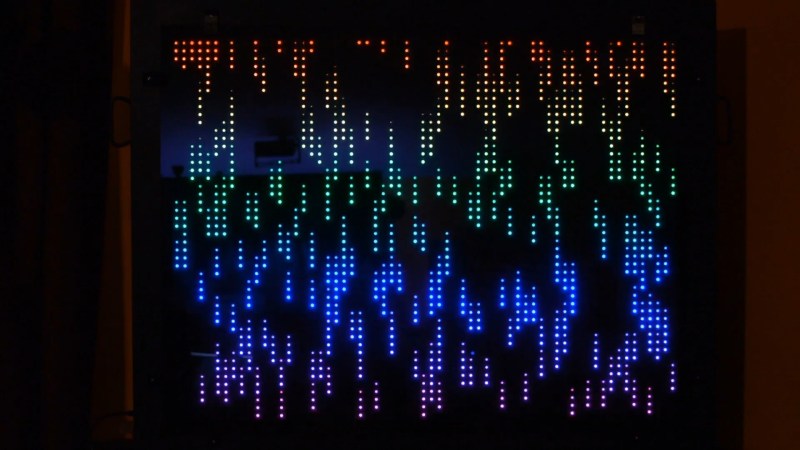“Should you answer a rhetorical question?” But anyway, the answer is that you can never have enough LEDs. At least that’s what [Adam Haile] at maniacallabs seems to think. So far, he’s up to 3,072.
We’ve reported on a previous big-LED build of [Adam]’s before, called the “Colossus”. And while this current display is physically smaller, it’s got a lot more LEDs. And that means a lot more, well, everything else. Weighing in at roughly 500W when full-on, with 175-part 3D printed frame and diffuser elements and driven by three Teensy 3.2 microcontrollers driving shift registers, this display is capable of putting out 60 frames per second of blinding RGB LED goodness.
The designs, adapter boards, and animation code will be posted once they’ve “had a chance to clean things up a little”. Here’s hoping that’s soon! [Edit: Code and designs are here. Thanks Adam!]
If you’re in the greater Washington DC area, you can even swing by the NoVA Maker Faire in Reston to check it out in person. If you do, tell ’em Hackaday sent you.















People reporting they have built displays with even more LEDs in 3… 2… 1…
Come to think of it I know someone who’ve built a 64k LED display including their own VGA to LEDs adapter, this seems to be the project page: https://wiki.hackerspace.pl/projects:q3kled
There are plenty of 4K LED displays around. Stage installations and commercial installations of huge video screens use modules of 128×64 (or something like that) that can be bus’d together.
pre-fabbed module pshaw how about hand assembling 32k LEDs: https://www.youtube.com/watch?v=f1YNyQqbiF0
LOVE THIS!
That’s an amazing LED display, but a kinda crappy TV. :)
great build, nice video, though there seems to be little difference in the darker colors, but i’m guessing that’s probably the camera’s dynamic range, not the LED screen.
A 4K OLED TV has about 25 million LEDs, for what it’s worth.
8,294,400 pixels for 4K
3 colours per pixel makes ~25 million :)
Assuming that it is RBG and not other arrangements e.g. RGBG that tries to put more green subpixels. http://www.oled-info.com/pentile
Needs a diffuser. great build !
This, all colours wash out otherwise, especially for cameras. Plus the linear brightness isn’t compatible with our eyes, you should adapt it to something of a log scale https://en.wikipedia.org/wiki/Lightness. You lose fidelity but you don’t really have it in the first place
You can see greater brightness changes with the low values (0 to 1 to 2 are very noticeable) where brightness values at the end are completely identical (200…255 has very little change in noticeable brightness)
Yes – a good approximation is to square the brightness value, and if possible use 10-12 bits of the result if you want really smooth greyscales.
I did basic square root on a project with good results e.g. FLOOR(256-SQRT(255-value)*16) in a pre-calc’d array
There is no such thing as “Too many LEDs”
Agree 100%
I also blame them for getting me sucked into electronics (at around 11) in the first place :-)
We need more cowbell!! i mean LED’s!!
Easier to take a cheap 1080 LED monitor and trick it into being a lower dot matrix image :) Same effect in the end.
not as bright
Code and designs are here: https://github.com/ManiacalLabs/WyoManiacalDisplay
The TV input seems to be producing some errors, as it’s showing red pixels where there should be none… what is up with that?
That number is easy to calculate. Take the Amp supply capacity of your power supply and see how many led’s it will drive.. one more than that is too many.
Alternately that doesn’t represent “too many LEDs” but instead represents too weak of a power supply :P
DAMN IT! I thought I was on the Reston group’s email list, yet here I am not finding out about the NoVa Maker Faire until a few hours after it’s over. Great publicity, guys… Maybe I’ll start an Arlington Maker Faire and not invite the Reston folks. Any D.C. area locals want to join me?